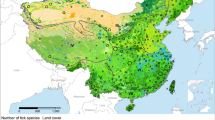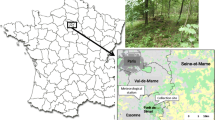Abstract
Systematic acarological surveys are useful tools in assessing risk to tick-borne infections, especially in areas where consistent clinical surveillance for tick-borne disease is lacking. Our goal was to identify environmental predictors of tick burdens on dogs and tick-borne infectious agents in dog-derived ticks in the Chiriquí Province of western Panama to draw inferences about spatio-temporal variation in human risk to tick-borne diseases. We used a model-selection approach to test the relative importance of elevation, human population size, vegetative cover, and change in landuse on patterns of tick parasitism on dogs. We collected 2074 ticks, representing four species (Rhipicephalus sanguineus, R. microplus, Amblyomma ovale, and Ixodes boliviensis) from 355 dogs. Tick prevalence ranged from 0 to 74% among the sites we sampled, and abundance ranged from 0 to 20.4 ticks per dog with R. sanguineus s.l. being the most commonly detected tick species (97% of all ticks sampled). Whereas elevation was the best single determinant of tick prevalence and abundance on dogs, the top models also included predictor variables describing vegetation cover and landuse change. Specifically, low-elevation areas associated with decreasing vegetative cover were associated with highest tick occurrence on dogs, potentially because of the affinity of R. sanguineus for human dwellings. Although we found low prevalence of tick-borne pathogen genera (two Rickettsia-positive ticks, no R. rickettsia or Ehrlichia spp.) in our study, all of the tick species we collected from dogs are known vectors of zoonotic pathogens. In areas where epidemiological surveillance infrastructure is limited, field-based assessments of acarological risk can be useful and cost-effective tools in efforts to identify high-risk environments for tick-transmitted pathogens.


Similar content being viewed by others
References
Alvarez-Calderon V, Hernandez Fonseca V, Hernandez Gamboa J (2005) Catálogo de garrapatas suaves (Acari: Argasidae) y duras (Acari: Ixodidae) de Costa Rica. Brenesia 63–64:81–88
Arsinoe IM, Hickling GJ, Ginsberg HS, McElreath R, Tsao JI (2015) Different populations of blacklegged tick nymphs exhibit differences in questing behavior that have implications for human Lyme disease risk. PLoS ONE 10:e0127450. doi:10.1371/journalpone0127450
Azad AF, Beard CB (1998) Rickettsial pathogens and their arthropod vectors. Emerg Infect Dis 4:179–186
Bermudez S, Miranda R (2011) Distribution of ectoparasites of Canis lupus familiaris L (Carnivora: Canidae) from Panama. Rev MVZ Cordoba 16:2274–2282
Bermúdez SE, Eremeeva ME, Karpathy SE, Samudio F, Zambrano ML, Zaldivar Y, Motta JA, Dasch GA (2009) Detection and identification of rickettsial agents in ticks from domestic mammals in eastern Panama. J Med Entomol 46:856–861
Bermúdez CSE, Zaldívar AY, Spolidorio MG, Moraes-Filho J, Miranda RJ, Caballero CM, Mendoza Y, Labruna MB (2011) Rickettsial infection in domestic mammals and their ectoparasites in El Valle de Antón, Coclé, Panamá. Vet Parasitol 177:134–138
Bermúdez S, Miranda R, Zaldívar Y, González P, Berguido G, Trejos D, Pascale JM, Labruna M (2012a) Detección de Rickettsia spp en ectoparásitos de animales domésticos y silvestres de la Reserva Natural Privada Cerro Chucantí y comunidades aledañas, Panamá, 2007–2010. Biomédica. doi:10.7705/biomedicav32i2390
Bermúdez SE, Castro A, Esser H, Liefting Y, García G, Miranda RJ (2012b) Ticks (Ixodida) on humans from central Panama, Panama (2010–2011). Exp Appl Acarol 58:81–88. doi:10.1007/s10493-012-9564-7
Bermúdez SE, Lyons C, García G, Zaldívar Y, Gabster A, Arteaga G (2013) Serologic evidence of human Rickettsia infection found in three locations in Panama. Biomédica 33:31–37
Bermúdez S, Castro A, Trejos T, García G, Gabster A, Miranda R, Zaldívar Y, Paternina L (2016) Distribution of spotted fever group rickettsiae in hard ticks (Ixodida: Ixodidae) from Panamanian urban and rural environments. EcoHealth 13:274–284
Brinkerhoff RJ, Gilliam WF, Gaines D (2014) Lyme disease, Virginia, USA, 2000–2011. Emerg Infect Dis 20:1661–1668
Calero C, Silva-Goytia R (1956) Studies on spotted fever, Q fever and exanthematous typhus in the Isthmus of Panama; incidence of specific antibodies for Rickettsia ricketsii, Coxiella burnetti and Rickettsia prowazekii, mooseri and prowazekii strains, in occupational groups of diverse geographical areas. Arch Med Panamenos 5:99–106
Calero C, Nunez JM, Silva Goytia R (1952) Rocky Mountain spotted fever in Panama; report of two cases. Am J Trop Med Hyg 1:631–636
Centers for Disease Control and Prevention (CDC) (1979) Tick Paralysis—Canal Zone, Panama MMWR morbidity and mortality weekly reports 28, pp 425–436
Childs JE, Paddock CD (2003) The ascendancy of Amblyomma americanum as a vector of pathogens affecting humans in the United States. Annu Rev Entomol 48:307–337. doi:10.1146/annurevento48091801112728
Cubilla A (2015) Resumen de la estimacion y proyeccion de la poblacion total de la provincia de Chiriqui, segun Districto, Corregimiento, y Sexo: Anos 2010–20 (Proyecciones de la Población del País No 81). Boletín 16 Estimaciones y proyecciones de la Población Total del País, por Provincia, Comarca Indígena, Distrito y corregimiento, según sexo y edad: años 2010–20 el Instituto Nacional de Estadística y Censo (INEC), de la Contraloría General de la República
Dantas-Torres F (2008) Canine vector-borne diseases in Brazil. Parasites Vectors 1:25. doi:10.1186/1756-3305-1-25
Dantas-Torres F (2010) Biology and ecology of the brown dog tick, Rhipicephalus sanguineus. Parasites Vectors 3:26. doi:10.1186/1756-3305-3-26
Dantas-Torres F, Otranto D (2011) Rhipicephalus sanguineus on dogs: relationships between attachment sites and tick developmental stages. Exp Appl Acarol 53:389–397. doi:10.1007/s10493-010-9406-4
Dantas-Torres F, Figueredo LA, Brandão-Filho SP (2006) Rhipicephalus sanguineus (Acari: Ixodidae), the brown dog tick, parasitizing humans in Brazil. Rev Soc Bras Med Trop 39:64–67
Dantas-Torres F, Ferreira DRA, de Melo LM, Lima P-ACP, Siqueira DB, Rameh-de-Albuquerque LC, de Melo AV, Ramos JAC (2010) Ticks on captive and free-living wild animals in northeastern Brazil. Exp Appl Acarol 50:181–189
De Campos Pereira M, SzabÓ MPJ, Bechara GH, Matushima ER, Duarte JMB, Rechav Y, Fielden L, Keirans JE (2000) Ticks (Acari: Ixodidae) associated with wild animals in the Pantanal region of Brazil. J Med Entomol 37:979–983. doi:10.1603/0022-2585-376979
de la Fuente J (2008) Overview: ticks as vectors of pathogens that cause disease in humans and animals. Front Biosci. doi:10.2741/3200
De Lucas J, García E, García G, Castro A, Lyons C, Bermúdez SE (2013) Nuevo caso de rickettsiosis humana en Panamá, a partir de evidencia serológica y clínica. Rev Médica Panamá 34:40–43
Demma LJ, Traeger MS, Nicholson WL, Paddock CD, Blau DM, Eremeeva ME, Dasch GA, Levin ML, Singleton J, Zaki SR, Cheek JE, Swerdlow DL, McQuiston JH (2005) Rocky Mountain spotted fever from an unexpected tick vector in Arizona. New Engl J Med 353:587–594. doi:10.1056/NEJMoa050043
Demma LJ, Eremeeva M, Nicholson WL, Traeger M, Blau D, Paddock C, Levin M, Dasch G, Cheek J, Swerdlow D, Mcquiston J (2006) An outbreak of Rocky Mountain spotted fever associated with a novel tick vector, Rhipicephalus sanguineus, in Arizona, 2004: Preliminary report. Ann N Y Acad Sci 1078:342–343
Didan K, Huete A (2006) MODIS vegetation index product series collection 5 change summary. TBRS Lab, The University of Arizona
Estrada-Peña A, de la Fuente J, Ostfeld RS, Cabezas-Cruz A (2015) Interactions between tick and transmitted pathogens evolved to minimize competition through nested and coherent networks. Sci Rep 5:10361. doi:10.1038/srep10361
Estripeaut D, Aramburú MG, Sáez-Llorens X, Thompson HA, Dasch GA, Paddock CD, Zaki S, Eremeeva ME (2007) Rocky Mountain spotted fever, Panama. Emerg Infect Dis 13:1763–1765. doi:10.3201/eid1311070931
Fairchild GB, Kohls GM, Tipton VJ (1966) The ticks of Panama (Acarina: Ixodiodea). In: Wenzel RL, Tipton VJ (eds) Ectoparasites of Panama. Field museum of natural history. Chicago, IL, pp 167–213
Falco RC, McKenna DF, Daniels TJ, Nadelman RB, Nowakowski J, Fish D, Wormser GP (1999) Temporal relation between Ixodes scapularis abundance and risk for Lyme disease associated with erythema migrans. Am J Epidemiol 149:771–776. doi:10.1093/oxfordjournalsajea009886
Finch C, Al-Damluji MS, Krause PJ, Niccolai L, Steeves T, O’Keefe CF, Diuk-Wasser MA (2014) Integrated assessment of behavioral and environmental risk factors for Lyme disease infection on Block Island, Rhode Island. PLoS ONE 9:e84758. doi:10.1371/journalpone0084758
Gage KL, Burkot TR, Eisen RJ, Hayes EB (2008) Climate and vectorborne diseases. Am J Prev Med 35:436–450. doi:10.1016/jamepre200808030
Gern L, Cadenas FM, Burri C (2008) Influence of some climatic factors on Ixodes ricinus ticks studied along altitudinal gradients in two geographic regions in Switzerland. Int J Med Microbiol 298:55–59. doi:10.1016/jijmm200801005
Glenn EP, Huete AR, Nagler PL, Nelson SG (2008) Relationship between remotely-sensed vegetation indices, canopy attributes and plant physiological processes: what vegetation indices can and cannot tell us about the landscape. Sensors 8:2136–2160. doi:10.3390/s8042136
Guglielmone AA, Estrada-Peña A, Mangold AJ, Barros-Battesti DM, Labruna MB, Martins JR, Venzal JM, Arzua M, Keirans JE (2003) Amblyomma aureolatum (Pallas, 1772) and Amblyomma ovale Koch, 1844 (Acari: Ixodidae): hosts, distribution and 16S rDNA sequences. Vet Parasitol 113:273–288
Guimarães JH, Battesti DMB, Tucci EC (2001) Ectoparasitos de importância veterinária. Pleiade, São Paulo
Guzman-Cornejo C, Robbins RG, Perez T (2007) The Ixodes (Acari: Ixodidae) of Mexico: parasite-host and host-parasite checklists. Zootaxa 1553:47–58
Huete AR, Restrepo-Coupe N, Ratana P, Didan K, Saleska SR, Ichii K, Panuthai S, Gamo M (2008) Multiple site tower flux and remote sensing comparisons of tropical forest dynamics in Monsoon Asia. Agric For Meteorol 148:748–760. doi:10.1016/jagrformet200801012
Jones KE, Patel NG, Levy MA, Storeygard A, Balk D, Gittleman JL, Daszak P (2008) Global trends in emerging infectious diseases. Nature 451:990–993. doi:10.1038/nature06536
Keesing F, Holt RD, Ostfeld RS (2006) Effects of species diversity on disease risk. Ecol Lett 9:485–498. doi:10.1111/j1461-0248200600885x
Keesing F, Belden LK, Daszak P, Dobson A, Harvell CD, Holt RD, Hudson P, Jolles A, Jones KE, Mitchell CE, Myers SS, Bogich T, Ostfeld RS (2010) Impacts of biodiversity on the emergence and transmission of infectious diseases. Nature 468:647–652. doi:10.1038/nature09575
Koch HG (1982) Oviposition of the brown dog tck (Acari: Ixodidae) in the laboratory. Ann Entomol Soc Am 75:583–586. doi:10.1093/aesa/755583
Koch HG, Tuck MD (1986) Molting and survival of the brown dog tick (Acari: Ixodidae) under different temperatures and humidities. Ann Entomol Soc Am 79:11–14. doi:10.1093/aesa/79111
Lantos PM, Brinkerhoff RJ, Wormser GP, Clemen R (2013) Empiric antibiotic treatment of erythema migrans-like skin lesions as a function of geography: a clinical and cost effectiveness modeling study. Vector Borne Zoonotic Dis 13:877–883. doi:10.1089/vbz20131365
Materna J, Daniel M, Metelka L, Harčarik J (2008) The vertical distribution, density and the development of the tick Ixodes ricinus in mountain areas influenced by climate changes (The Krkonoše Mts, Czech Republic). Int J Med Microbiol 298:25–37. doi:10.1016/jijmm200805004
Medlock JM, Hansford KM, Bormane A, Derdakova M, Estrada-Peña A, George J-C, Golovljova I, Jaenson TG, Jensen J-K, Jensen PM, Kazimirova M, Oteo JA, Papa A, Pfister K, Plantard O, Randolph SE, Rizzoli A, Santos-Silva MM, Sprong H, Vial L, Hendrickx G, Zeller H, Van Bortel W (2013) Driving forces for changes in geographical distribution of Ixodes ricinus ticks in Europe. Parasites Vectors 6:1. doi:10.1186/1756-3305-6-1
Mills J, Childs JE (1998) Ecologic studies of rodent reservoirs: their relevance for human health. Emerg Infect Dis 4:529–537. doi:10.3201/eid0404980403
Mills JN, Gage KL, Khan AS (2010) Potential influence of climate change on vector-borne and zoonotic diseases: a review and proposed research plan. Environ Health Perspect 118:1507–1514. doi:10.1289/ehp0901389
Moraes-Filho J, Marcili A, Nieri-Bastos FA, Richtzenhain LJ, Labruna MB (2011) Genetic analysis of ticks belonging to the Rhipicephalus sanguineus group in Latin America. Acta Trop 117:51–55. doi:10.1016/jactatropica201009006
Murgas IL, Castro AM, Bermúdez SE (2013) Current status of Amblyomma ovale (Acari: Ixodidae) in Panama. Ticks and Tick-borne Diseases 4:164–166. doi:10.1016/jttbdis201209002
Okoli IC, Okoli CG, Opara M (2006) Environmental and multi-host infestation of the brown dog tick, Rhipicephalus sanguineus in Owerri, south-east Nigeria: a case report. Vet Arh 76:93–100
Oliver JH (1989) Biology and systematics of ticks (Acari: Ixodida). Annu Rev Ecol Syst 20:397–430. doi:10.1146/annureves20110189002145
Ostfeld RS, Levi T, Jolles AE, Martin LB, Hosseini PR, Keesing F (2014) Life history and demographic drivers of reservoir competence for three tick-borne zoonotic pathogens. PLoS ONE 9:e107387. doi:10.1371/journalpone0107387
Otranto D, Dantas-Torres F, Breitschwerdt EB (2009) Managing canine vector-borne diseases of zoonotic concern: part one. Trends Parasitol 25:157–163. doi:10.1016/jpt200901003
Parola P, Raoult D (2001) Ticks and tick-borne bacterial diseases in humans: an emerging infectious threat. Clin Infect Dis 32:897–928. doi:10.1086/319347
Parola P, Paddock CD, Raoult D (2005) Tick-borne rickettsioses around the world: emerging diseases challenging old concepts. Clin Microbiol Rev 18:719–756. doi:10.1128/CMR184719-7562005
Parola P, Socolovschi C, Jeanjean L, Bitam I, Fournier P-E, Sotto A, Labauge P, Raoult D (2008) Warmer weather linked to tick attack and emergence of severe rickettsioses. PLoS Neglected Trop Dis 2:e338. doi:10.1371/journalpntd0000338
Perret JL, Guerin PM, Diehl PA, Michele V (2003) Darkness induces mobility, and saturation deficit limits questing duration, in the tick Ixodes ricinus. J Exp Biol 206:1809–1815. doi:10.1242/jeb00345
Randolph SE (2009) Tick-borne disease systems emerge from the shadows: the beauty lies in molecular detail, the message in epidemiology. Parasitology 136:1403. doi:10.1017/S0031182009005782
Rizzoli A, Silaghi C, Obiegala A, Rudolf I, Hubalek Z, Foldvari G, Plantard O, Vayssier-Taussat M, Bonnet S, Spitalska E, Kazimirova M (2014) Ixodes ricinus and Its transmitted pathogens in urban and peri-urban areas in Europe: new hazards and relevance for public health. Front Public Health. doi:10.3389/fpubh201400251
Rodaniche EC (1953) Natural infection of the tick, Amblyomma cajennense, with Rickettsia rickettsii in Panama. Am J Trop Med Hyg 2:696–699
Rodaniche EC, Rodaniche A (1950) Spotted fever in Panama; isolation of the etiologic agent from a fatal case. Am J Trop Med Hyg 30:511–517
Rubini AS, Paduan KS, Martins TF, Labruna MB, O’Dwyer LH (2009) Acquisition and transmission of Hepatozoon canis (Apicomplexa: Hepatozoidae) by the tick Amblyomma ovale (Acari: Ixodidae). Vet Parasitol 164:324–327. doi:10.1016/jvetpar200905009
Sabatini GS, Pinter A, Nieri-Bastos FA, Marcili A, Labruna MB (2010) Survey of ticks (Acari: Ixodidae) and their Rickettsia in an Atlantic rain forest reserve in the State of São Paulo, Brazil. J Med Entomol 47:913–916
Santamaria A, Calzada JE, Saldaña A, Yabsley MJ, Gottdenker NL (2014) Molecular diagnosis and species identification of Ehrlichia and Anaplasma infections in dogs from Panama, Central America. Vector-borne Zoonotic Dis 14:368–370
Silva N, Eremeeva ME, Rozental T, Ribeiro GS, Paddock CD, Ramos EAG, Favacho ARM, Reis MG, Dasch GA, de Lemos ERS, Ko AI (2011) Eschar-associated spotted fever rickettsiosis, Bahia, Brazil. Emerg Infect Dis 17:275–278. doi:10.3201/eid1702100859
Spolidorio MG, Labruna MB, Mantovani E, Brandão PE, Richtzenhain LJ, Yoshinari NH (2010) Novel spotted fever group rickettsiosis, Brazil. Emerg Infect Dis 16:521–523. doi:10.3201/eid1603091338
Szabó MPJ, Nieri-Bastos FA, Spolidorio MG, Martins TF, Barbieri AM, Labruna MB (2013) In vitro isolation from Amblyomma ovale (Acari: Ixodidae) and ecological aspects of the Atlantic rainforest Rickettsia, the causative agent of a novel spotted fever rickettsiosis in Brazil. Parasitology 140:719–728. doi:10.1017/S0031182012002065
Tiengo A, Fedele D, Marchiori E, Nosadini R, Muggeo M (1976) Suppression and stimulation mechanisms controlling glucagon secretion in a case of islet-cell tumor producing glucagon, insulin, and gastrin. Diabetes 25:408–412
Tribaldos M, Zaldivar Y, Bermudez S, Samudio F, Mendoza Y, Martinez AA, Villalobos R, Eremeeva ME, Paddock CD, Page K, Smith RE, Pascale JM (2011) Rocky Mountain spotted fever in Panama: a cluster description. J Infect Dev Ctries. doi:10.3855/jidc2189
Troyo A, Moreira-Soto A, Carranza M, Calderón-Arguedas O, Hun L, Taylor L (2014) Detection of an undescribed Rickettsia sp in Ixodes boliviensis from Costa Rica. Ticks Tick Borne Dis 5:883–886. doi:10.1016/jttbdis201407017
Uspensky I, Ioffe-Uspensky I (2002) The dog factor in brown dog tick Rhipicephalus sanguineus (Acari: Ixodidae) infestations in and near human dwellings. Int J Med Microbiol 291:156–163. doi:10.1016/S1438-4221(02)80030-3
Acknowledgements
We are indebted to the many residents of Chiriquí who participated in this Project by allowing tick collection from their dogs. AMF was funded, in part, by a Robert F. Smart Summer Fellowship at the University of Richmond and this Project was initiated in collaboration with the School for Field Studies. We would also like to thank the anonymous reviewers whose feedback allowed us to make important improvements to this manuscript.
Author information
Authors and Affiliations
Corresponding author
Ethics declarations
Ethical standard
All applicable institutional guidelines for the care and use of animals were followed and the protocols implemented in this work were reviewed and approved by the Institutional Review Board of the School for International Training (SIT) Panama: Tropical Ecology, Marine Ecosystems, and Biodiversity Conservation. This article does not contain any studies with human participants performed by any of the authors.
Rights and permissions
About this article
Cite this article
Ferrell, A.M., Brinkerhoff, R.J., Bernal, J. et al. Ticks and tick-borne pathogens of dogs along an elevational and land-use gradient in Chiriquí province, Panamá. Exp Appl Acarol 71, 371–385 (2017). https://doi.org/10.1007/s10493-017-0116-z
Received:
Accepted:
Published:
Issue Date:
DOI: https://doi.org/10.1007/s10493-017-0116-z




